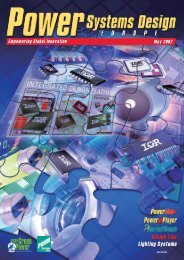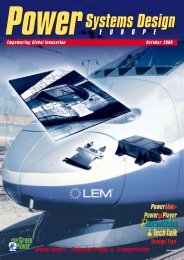Testing Virtual ECUs - Power Systems Design
Testing Virtual ECUs - Power Systems Design
Testing Virtual ECUs - Power Systems Design
You also want an ePaper? Increase the reach of your titles
YUMPU automatically turns print PDFs into web optimized ePapers that Google loves.
14<br />
DESIGNtips<br />
Figure 6: Five-Output Coupled-Inductor Winding Layout<br />
level. The value of 26 was chosen<br />
since it allows us to exactly the<br />
match the transformer turns<br />
ratio when 10 turns are placed<br />
on the bias winding of the<br />
inductor. Normally for a forward<br />
converter inductor, the value<br />
of inductance and the number<br />
of turns are determined by the<br />
current level and core area. In<br />
the case of the coupled inductor<br />
design, however, maintaining the<br />
proper turns ratio is paramount,<br />
and the number of turns is set<br />
by this requirement. This allows<br />
the value of inductance to be<br />
increased as a consequence.<br />
It must be remembered that in<br />
magnetics design, we have many<br />
degrees of freedom, and there<br />
are no hard rules determining the<br />
value of an output inductor. It is<br />
important not to overconstrain<br />
thinking, a common error<br />
of many design books on<br />
magnetics. For example,<br />
many texts will fix the value of<br />
inductance to give a specified<br />
ripple current, but this removes<br />
freedom for the designer to<br />
choose a value that, in reality,<br />
WWW.POWERSYSTEMSDESIGN.COM<br />
can be varied over a significant<br />
range without detriment to the<br />
overall performance.<br />
The layout of the new inductor is<br />
shown in Figure 6. Each winding<br />
occupies a single layer of the<br />
inductor, with the wire gauge<br />
choses to exactly fill the layer<br />
neatly. The final layer is the 10<br />
turns of bias winding, using<br />
triple insulated wire.<br />
Summary<br />
The turn of a PC board is usually<br />
a major project milestone. It<br />
presents the opportunity to clean<br />
up previous errors in a board,<br />
improve manufacturability, and<br />
move a step further towards a<br />
final product.<br />
However, in many projects, the<br />
PC board iteration is often seen<br />
as an opportunity to revisit<br />
project goals, and make major<br />
changes to a design project<br />
and its specifications. In this<br />
particular project, a large number<br />
of changes have been made, and<br />
the risk of incorporating these<br />
changes has to be balanced<br />
against the potential gains in the<br />
final product. The risk here is not<br />
too great since there is always<br />
the option of reverting back to<br />
the previous design of just three<br />
outputs if the regulation achieved<br />
during testing is insufficient.<br />
It must be stated, however,<br />
that substantial changes to<br />
components, especially the<br />
magnetics, will result in the<br />
need to reiterate much of the<br />
testing of the power supply,<br />
and the time to do this must<br />
not be underestimated. The<br />
changed turns of the transformer<br />
and inductor will affect the<br />
cross-regulation, EMI, ringing,<br />
snubbers, current protection, and<br />
semiconductor stresses.<br />
If the second iteration had<br />
been undertaken with none of<br />
these changes, and the design<br />
remained unchanged with three<br />
outputs, there is a reasonable<br />
expectation that this would be the<br />
final PC layout before production.<br />
However, the substantial changes<br />
make it likely that a third layout<br />
pass will be needed before<br />
finishing the design.<br />
Author: Dr. Ray Ridley<br />
President<br />
Ridley Engineering<br />
www.ridleyengineering,com<br />
POWER SYSTEMS DESIGN JULY/AUGUST 2011<br />
MULTI-DOMAIN SIMULATION<br />
Automotive power electronics components and systems<br />
By Thorsten Gerke & Kurt Mueller<br />
Electrification is driving the need for comprehensive multidomain<br />
system simulation in hybrid-electric and electric<br />
vehicles.<br />
A<br />
Cover Story<br />
vehicle’s power<br />
electronic<br />
components, coupled<br />
with the overall<br />
power management and control<br />
system, introduces a new set<br />
of challenges for electrical<br />
system design. These power<br />
electronic components include:<br />
energy storage devices (such as<br />
batteries, ultracapacitors), DC/DC<br />
converters, inverters, and drives.<br />
SaberRD, the latest addition to the<br />
Synopsys® automotive product<br />
portfolio, is designed for modeling<br />
and simulating power electronics<br />
with a focus on addressing the<br />
challenges of integrated power<br />
system design and validation.<br />
The combination of electrical<br />
drive systems to traditional low<br />
voltage power networks takes the<br />
design challenge of vehicle level<br />
efficiency to new dimensions.<br />
Weight, aerodynamics and engine<br />
efficiency have always been a<br />
significant consumer of vehicle<br />
power. In today’s complex vehicle<br />
designs, the electrothermal and<br />
Figure 1: Structure of the SaberRD environment<br />
electromagnetic behavior of DC/<br />
DC converters, electric motors,<br />
and drives are a significant<br />
piece of overall vehicle power.<br />
Consumer demands for greater<br />
fuel efficiency, reduced carbon<br />
footprint along with traditional<br />
vehicle performance require new<br />
and creative trade-offs between<br />
important system characteristics<br />
that can only be done at an<br />
integrated, multi-domain level.<br />
During a panel discussion at<br />
Convergence 2010 in Detroit,<br />
Michigan, Senior Chief Engineer<br />
from Honda, Yoshio Suzuki,<br />
emphasized that carmakers need<br />
more support from software<br />
providers to help them model and<br />
simulate complete systems in an<br />
electronics context. SaberRD was<br />
developed specifically to target this<br />
need: an intuitive tool for power<br />
electronics design, validation and<br />
system integration built upon 25<br />
years of experience and success in<br />
the power electronics industry.<br />
The complexity of modeling and<br />
simulating physical systems<br />
can be daunting, especially for<br />
someone coming from a less<br />
power-electronics focused point of<br />
view. As a result, tool developers<br />
are faced with a delicate balancing<br />
WWW.POWERSYSTEMSDESIGN.COM<br />
15









